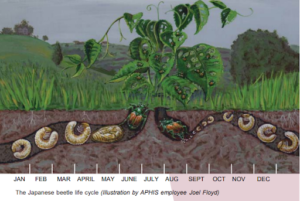What may look like a pretty green and iridescent beetle actually spells doom for homeowners and the Gardens alike.
The Japanese Beetle, Popillia japonica, has been out in full force here at the Gardens in the last couple weeks and we have been doing our best to manage them using mechanical control rather than insecticides or traps. This means, we’re picking beetles off the plants and dropping them into a cup of soapy water to kill them. Is this the most effective method? No. However, it is a much more environmentally safe method, especially when we are at peak season for tours and summer camp programs. If left unchecked, the population of these beetles will not only defoliate many of our plants but will also lay more eggs and return to do the same next year.

Let’s explore a little bit about the life cycle of Japanese Beetles…
What we see in the gardens right now are the adult Japanese beetles, and often we can see them clustered together, mating. Throughout this mating period, female beetles will fly off, burrow around 3 inches deep into the soil, and lay some eggs. Each female can do this multiple times, laying as many as 60 eggs per mating season.
The eggs will hatch into white grubs, which eat plant roots. These grubs are the number one pest to turf grass in the United States. In Autumn, the grubs bury themselves deeper into the soil (4-8 inches) to overwinter. Come next Spring, the grubs return to their place, feeding on roots, before pupating and finally, hatching out as adults above-ground.

So what can we do?
Chemical insecticides are a viable method of control, but you must assess the type of chemical and the application method, and choose the right time to apply the chemical, as they can have serious health and environmental consequences. A list of effective chemicals can be found in the following USDA Homeowner’s Guide: https://www.aphis.usda.gov/plant_health/plant_pest_info/jb/downloads/JBhandbook.pdf
Biological controls involve using other organisms to infect or kill the adult beetle or grub populations. Things that fall into this category are parasites, nematodes, and fungi. The benefit of using a biological control is that it is much less likely to affect non-target organisms- including you! Commercially available products include St. Gabriel Organics’ Milky Spore formulation and NemaSeek®. Find more information on biological controls for Japanese beetles here: https://ipm.missouri.edu/MEG/2018/1/organic_management_japanese_beetle/
You can also use cultural methods of control. This involves things like using plants that are less susceptible to becoming feeding grounds for adult beetles. This method is less likely to decrease the population of beetles but more likely to not have them feeding in your yard. A list of resistant plants can be found in the USDA Homeowner’s Guide listed above.
Finally, there is mechanical control. This involves trapping members of the insect population to kill them and prevent them from growing or breeding. Pheromone-based traps are a commonly used method; however, they are meant for monitoring adult beetle populations and have attractants in them to lure beetles in. This means you are attracting the neighborhood’s beetles to your yard, and subsequently, your plants. Pheromone traps are not effective for protecting your own yard from Japanese beetles. Plucking beetles from plants to put them in soapy water also falls under mechanical control.
Managing the population by catching adult beetles is also a control method that poses no ill effects to you, the environment, or local wildlife!
While it may seem tedious and even gross, collecting adult beetles (without luring them) reduces the breeding population and prevents some of the females from laying more eggs. This will hopefully mean that next year’s population is not as large as it would be, had we not attempted any control methods. We will continue to monitor our efforts and that of the Japanese Beetles, and we hope this helps you do the same.



